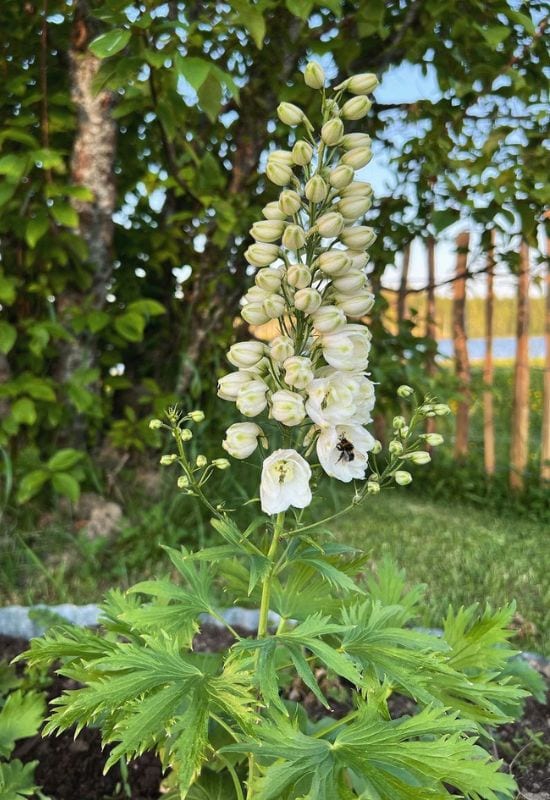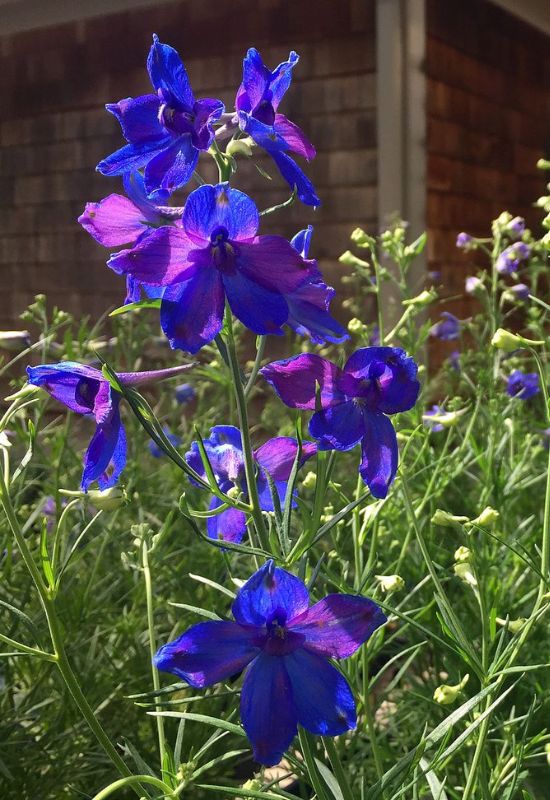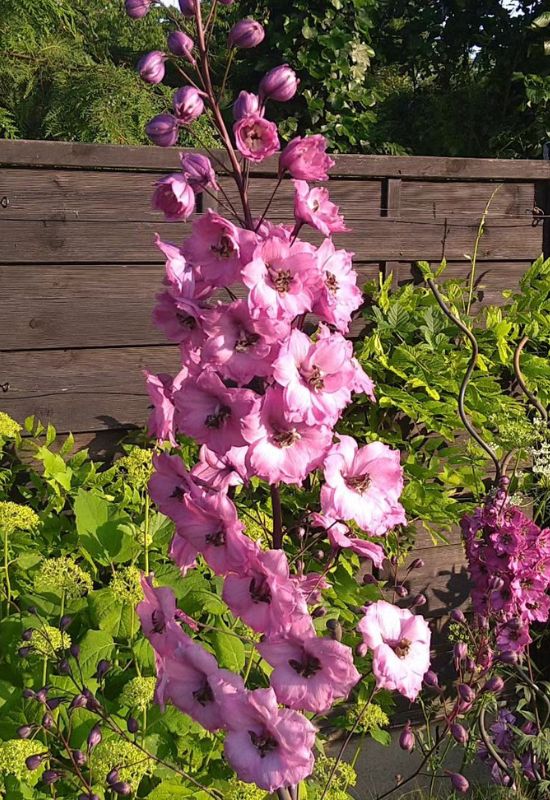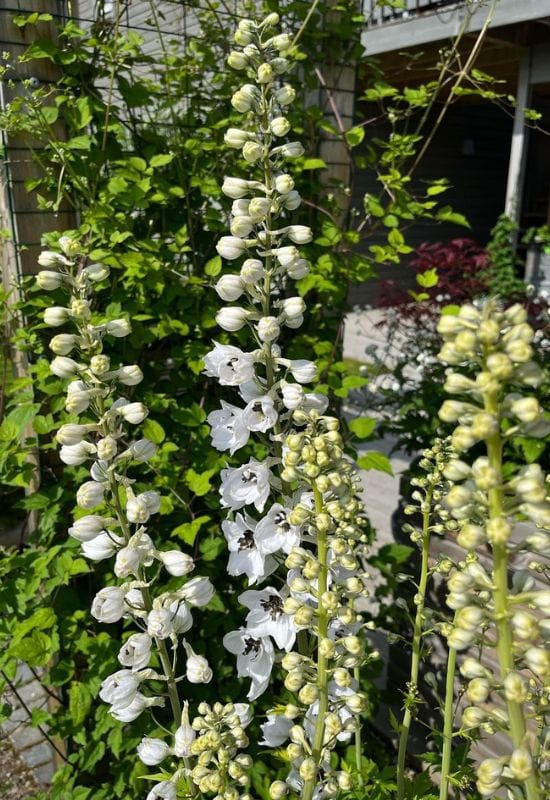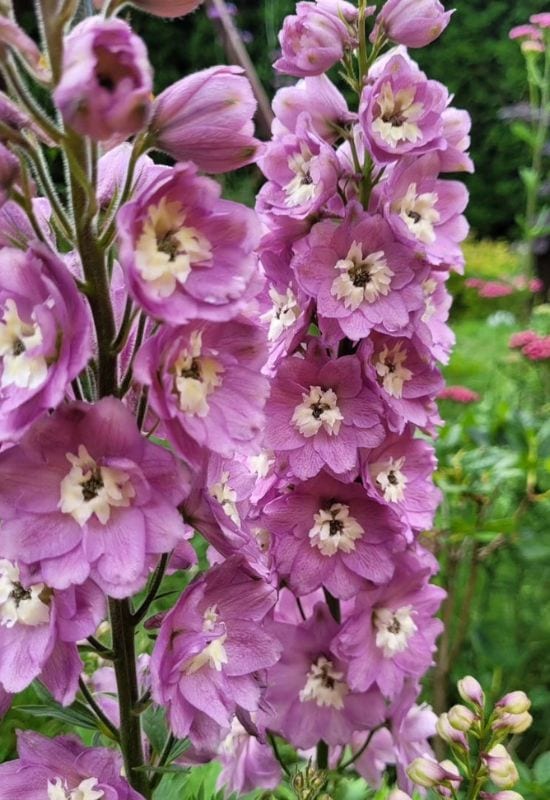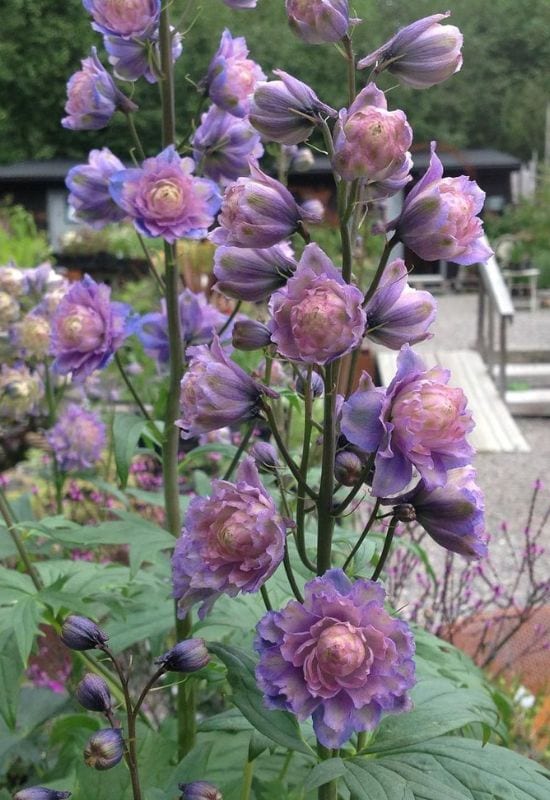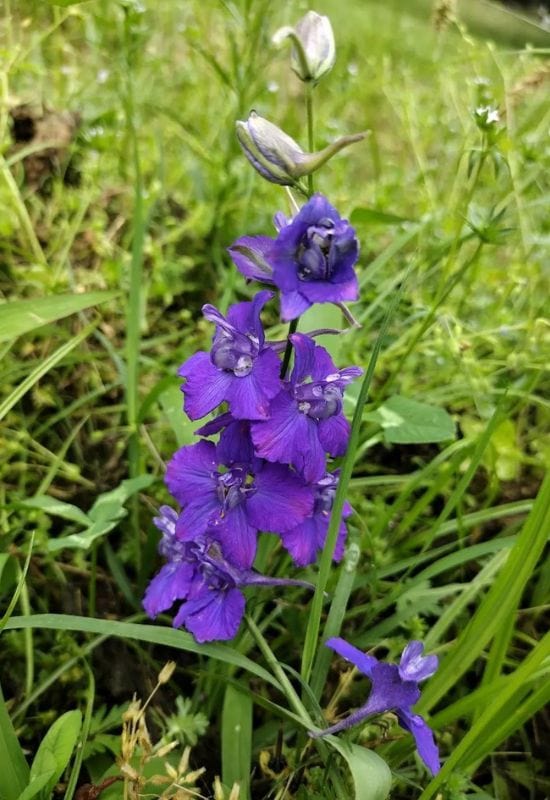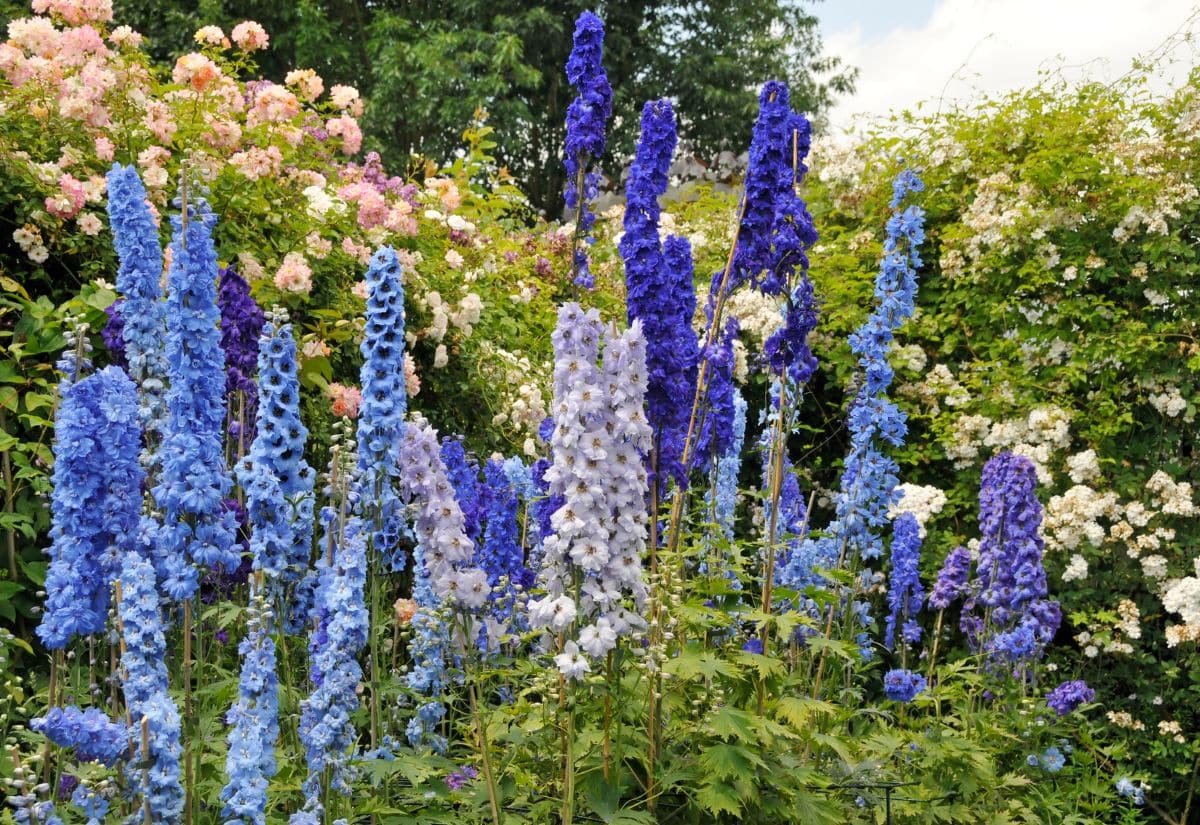
Rising above the lush and deeply cut foliage, delphiniums are popular for structuring prairie-style gardens and, are invaluable for introducing vertical accents and focal points in beds, borders, or pots near the house.
Their long and colorful flower stalks of spurred flowers come in shades of blue, violet, pink, red, yellow, white, and purple, drawing butterflies, bees, other pollinators, and even hummingbirds to your garden from all around.
Also called larkspur, this cold-hardy, floriferous plant, whether perennial or annual, adds charm to English cottages and transforms a simple bed of perennials into a chic mixed border. These slender blossoms, always noticeable in a garden, evoke memories of summer days spent in the countryside, on wild meadows, or strolling to admire cottage and rural gardens.
If you want to infuse this dreamy ambiance into your garden, you have many larkspur varieties to choose from.
Delphinium is a genus of herbaceous plants in the Ranunculaceae family. It is native to the temperate regions of the northern hemisphere. The genus encompasses nearly 400 distinct species and even more cultivars. The majority of these plants are perennials, though there are also annual and biennial varieties within the genus.
Their diversity shines through in their colors, bloom periods, sizes, and flower shapes. Most delphiniums bloom from June to August, and some might bloom again in October if you prune them after their first bloom.
Some varieties remain relatively short, making them suitable for mid-border plantings, while others can grow over 2 meters tall, serving as backdrops in flower beds.
The flowers vary, from densely packed to loosely arranged, from large to petite, and from single to double-petaled. Some sprout from branched stems, while others grow from singular ones.
Choosing the perfect delphinium type from such a broad range can be overwhelming. To help you decide, I’ve curated a list of 16 standout delphinium varieties.
So, join me on this enlightening exploration of the landscapes painted with delphiniums.
But first, let’s dive into a few fascinating facts about these botanical wonders.
A Fun Fact and a Scary Fact about Delphinium
Larkspurs are some of the oldest cultivated plants we know of, but you may wonder why they are called “delphinums”? It clearly refers to dolphins, and in fact it comes from the Ancient Greek “delphinion”.
But why? It was called so in a Latin herbalist book by physician Pedanius Dioscorides, as a medical herb, entitled De materia medica (“on the medical subject”) and he thought that the flowers of our plants looked like dolphins…
Then again, it was a long time ago, as that 5-volume work was written between 50 and 70 CE… And this is possibly due to the spur that you find at the back of the blooms, which looks like a cetacean tail, but in many modern cultivars, these are hidden by their dense floral displays.
But this leads us to the scary fact: all species and cultivars in the Delphinium genus are highly toxic to both humans and animals, so, watch them, admire them, grow them, but never eat them!
So, in all safety, we can start looking at our beautiful delphinium varieties!
16 Delphinium Varieties for a Garden Full of Flowers, Colors, and Loads of Butterflies!
And here is our selection; we picked some of the most striking and showy varieties of delphiniums, but also some less known larkspurs, to show you a full range of colors but also sizes and personalities…
1. ‘Black Knight’ Pacific Delphinium (Delphinium xelatum ‘Black Knight’)
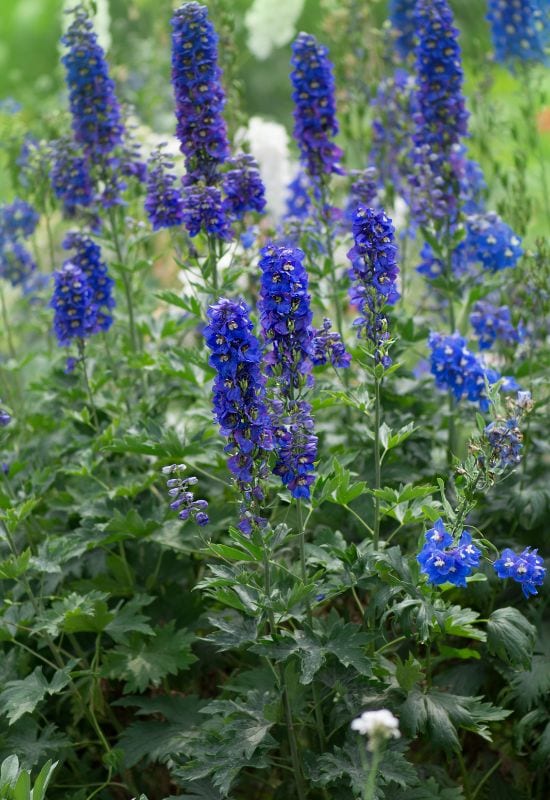
Following the old world theme, and the toxic nature of larkspurs, I’d like to start with a hybrid Pacific cultivar with a spooky name: ‘Black Knight’. This variety is noted for the very deep, intense and dark color of its many large and semi double blooms, that rise to about 1.8 feet into the air (1.8 meters).
In early and mis summer, the flowers open starting from the base and climb up the upright stem in a dense raceme. Their exact shade can range, from deep midnight blue to violet purple, but they are all distinguished by a black blotch in the middle of the saucer shaped blossoms, with the spurs hidden by the dense floral display itself.
In fact, it is more of a series than a single variety, but all have the lush mound of broad and deeply cut mid green foliage that forms a leafy base to the floral display.
‘Black Knight’ Pacific delphinium will bring a striking vertical accent to borders, beds or containers with its deep blue or purple colored blossoms; of course, it requires a traditional or at least informal space and it really is at home in a cottage garden.
2. ‘Princess Caroline’ Delphinium (Delphinium xelatum ‘Princess Caroline’)
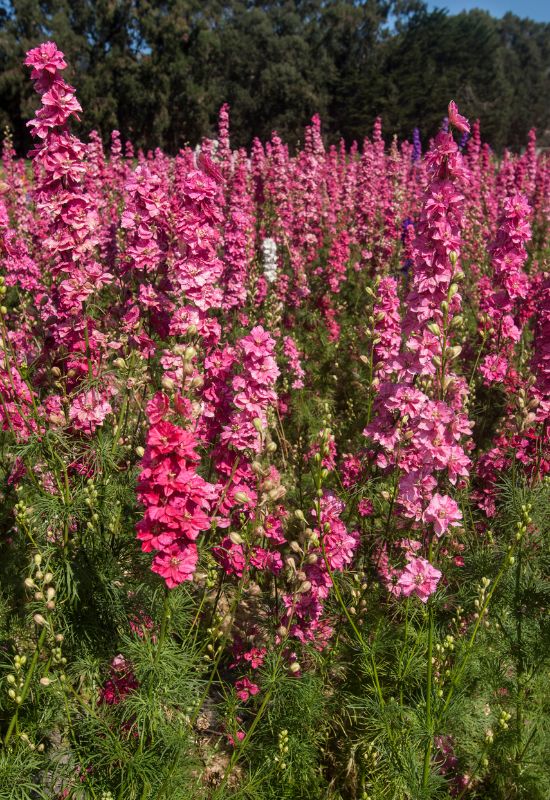
But now we want to meet a variety with a totally different personality from ‘Black Night’, and it comes with the sweet name of ‘Princess Caroline’. It will not grow too tall, only up to 3 feet (90 cm), but the spikes (upright racemes, actually) that rise from the ground are packed with large and frilly and double flowers, and these are quite large, about 2.4 inches across (6.0 cm).
And then we need to talk about the color… It is all within the pink range, but with different shades, including soft and shell, but also salmon and then, especially at the edges of the petals, the blooms blush to deep rose and even strawberry and magenta! This gives it a romantic but also energetic look, which is only heightened when butterflies come to visit the floral display above the broad and decorative cut and mid green leaves at the base.
Of course, you will want to grow ‘Princess Caroline’ delphinium in an old fashioned and romantic landscape, where it can really bring you that dreamy sensation of beating hearts and Jane Austen novels. It can also suit flower beds, being short. Yet again a cottage garden must have, this candle larkspur will suit all informal styles, especially if mass planted.
3. ‘Guardian White’ Delphinium (Delphinium xelatum ‘Guardian White’)
And now we come to the candid queen of candle larkspurs: ‘Guardian White’ delphinium! Rising to 4 feet tall (1.2 meters) its sturdy stem brings the packed double blossoms up towards your eye, ready to wow you with the super candid, luminous snow color of the elliptical but softly pointed petals.
The effect is serene, literally, thanks to the round flowers and sense of innocent permanence of this long lasting floral display. The inflorescence is also very dense, and with a really harmonic shape, like cylinders of snowflakes growing up from the ground and coming to meet you.
It may even look like a bribe walking towards the altar, and the luminous but neutral shade of the blooms is a perfect backdrop for colorful butterfly wings! The rich green foliage with its broad leaves with deep cuts also adds to the joyful and wedding party look of this cultivar, but it is narrower than most of her sisters, which give it a columnar shape.
Ideal to bring light and candor to your flower beds or borders, but also in containers or as a cut flower (maybe for a wedding bouquet), ‘Guardian White’ is one of the “whitest” perennials you can grow in an informal summer garden, and it is also great for a snowy vertical accent.
4. ‘Sunny Skies’ Delphinium (Delphinium xelatum ‘Sunny Skies’)
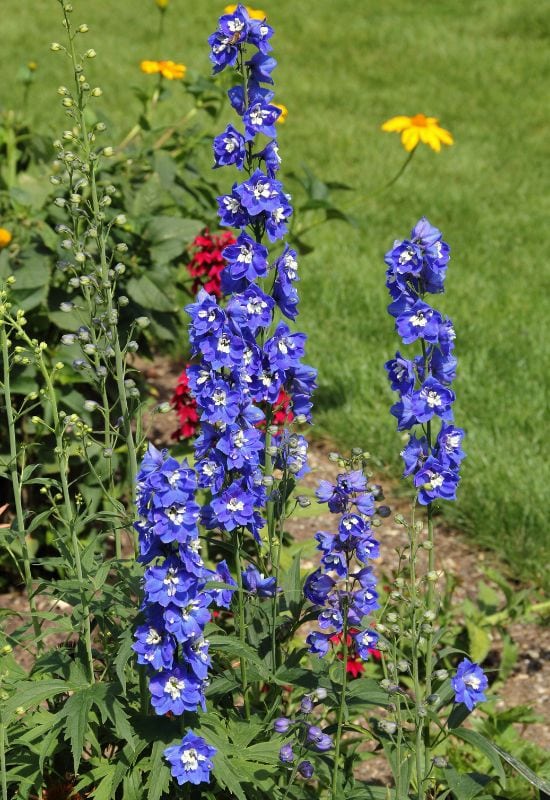
‘Sunny Skies’ is really the perfect name for this delphinium variety from the New Millennium Series! There is nothing more heavenly than its long and upright spikes, that rise into the air, reaching 6 feet tall (1.8 meters) and it will seem to you that an innocent child is looking at you straight into your eyes…
And what eyes! The flowers are of the most amazing bright shades of blue, with cyan, sky blue and even azure tonalities! But move closely and you will also notice some lavender showing through, especially in the ring of small petals (petaloids) in the center. Yes, because its blooms are semi double, and the petals are kind of pointed, almost triangular and gently filled at the margins.
You may even think you can see through them, as they are also thin… What is more, the racemes are loose, with gaps between the blossoms, which gives this larkspur an amazingly airy, open and light personality! And its blooming season is also much longer than the average, as it keeps going into the beginning of fall!
‘Sunny Skies’ is an enchanting delphinium with the most serene and light blue blossoms, but despite its heavenly appearance, it is also more tolerant to heat and humidity than other varieties, being of the New Millennium Series. Of course, it can literally bring down the heavens to earth and into your flower beds and containers. Again, for azure tonalities in a cottage garden, it is a must have!
5. ‘Summer Nights’ Chinese Delphinium (Delphinium grandiflorum ‘Summer Nights’)
Also called Siberian larkspur, ‘Summer Nights’Chinese delphinium is a short lived perennial, often treated as an annual. It is much smaller than the common D. elatumvarieties, keeping close to the ground with its 12 inches in height (30 cm)…So, it is totally different from what you would expect, also because the racemes are very open, with the asymmetrical flowers scattered and spaced.
Having said this, the blooms are really spectacular, looking a bit like butterflies, with 5 petals (and the top one is smaller) and quite large, up to 2 inches across (5.0 cm)! What is more, they will keep opening till the end of summer, attracting lots of butterflies and bees…
But its main asset is the amazingly vibrant cobalt to midnight blue color of the spurred blossoms, and, with this species, you can finally see the reason for the common name… Two little pale anthers appear in the middle, like snails’s eyes staring at you… And the foliage is different as well… The leaves are literally fern like, bright to mid, even emerald green, and with an amazingly fine texture.
‘Summer Nights’ Chinese delphinium is too small for herbaceous borders, but it will bring its vibrant blue blooms to flower beds and rock gardens, or in edging and in containers. You can also have it for a little posy during the summer months.
6. ‘Pacific Giant Astolat’ Delphinium (Delphinium xelatum ‘Pacific Giant Astolat’)
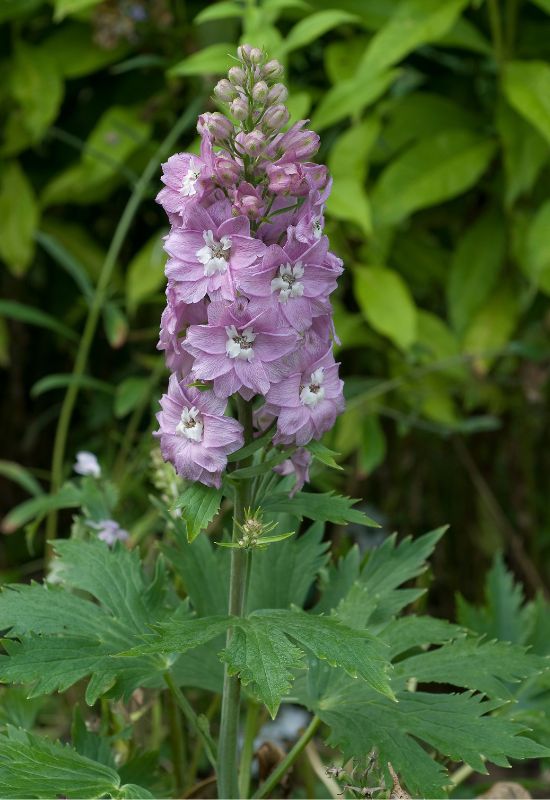
Back to a tall variety, we meet ‘Pacific Giant Astolat’, which grows to 1.8 feet into the air (1.8 meters) and comes to meet you face to face with its floral display… The vertical racemes carry large semi double blossoms, up to 2.4 inches across (6.0 cm), and they are fairly spaced on the stem.
But they also have a different habit from most others… Instead of opening full out into a saucer, the flowers keep a slightly more cupped shape, hanging ob very thin petioles… And now we come to the palette of the blooms…
They are lavender pink, but with subtle variations on each petal, sometimes tending to magenta, sometimes taking on paler and pastel tonalities. This gives it a rather wild look, very natural, but also showy at the same time. The foliage comes with the classically broad and deeply cut leaves of D. elatum, in mid green.
‘Pacific Giant Astolat’ may not be an easy candle larkspur variety to fit in an herbaceous border or at the back of a flower bed; you need to have a very naturalistic style in your green haven, like a cottage or countryside garden, but as a vertical accent plant, it is really worth growing.
7. Giant Larkspur (Delphinium ajacis, or Consolidaajacis)
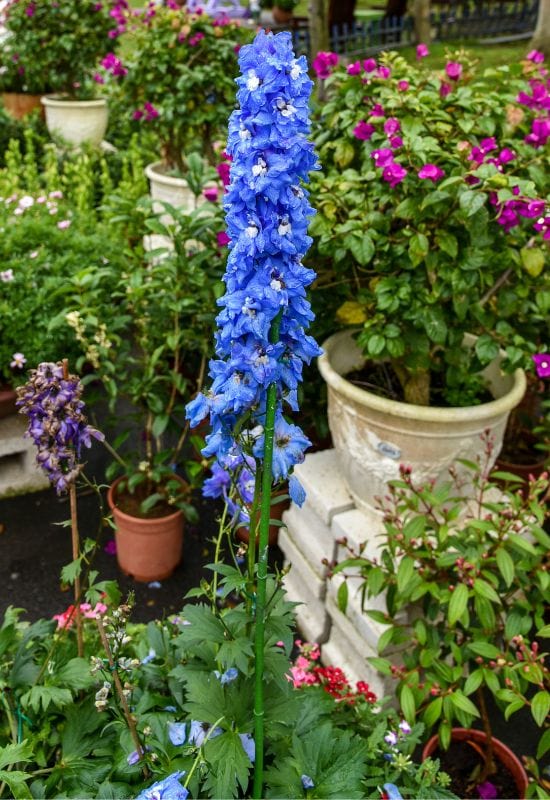
Here is an annual variety of delphinium for your garden, called giant larkspur, and it reaches 4 feet in height (1.2 meters) with its elegant upright stems, that carry a loose panicle of large single blossoms with 5 petals (tepals) that are not actually spurred at the back, but they are big, at about 2 inches in diameter (5.0 cm).
The flowers will last all summer, they they can be deep purple, strong or pale blue, vibrant pink or white! In the middle, there is a single pistil, while the anthers of the few stamens have an unusual color as well: azure! Loved by butterflies and pollinators, it is also a fast growing plant, and in hot climates it will die back after its blossom, by early fall.
But in this period, you will also enjoy its rich green and fern like foliage, with soft and needle like leaflets, which will give your garden a sophisticated and very fine texture.
Giant larkspur is an ideal annual for herbaceous borders in an informal space, and once more very typical of cottage gardens; but it can suit a wild meadow or prairie as well, and it will look its best if you mass or group plant it.
8. ‘Pink Punch’ Delphinium (Delphinium x elatum ‘Pink Punch’)
Let’s now meet a classic looking variety, tall and charming, ‘Pink Punch’ delphinium… It will grow to up to 5 feet tall (1.5 meters) and form dense cones with its inflorescence, which have some sculptural quality as well, despite the herbaceous nature of this perennial.
And the large blooms are about 2 inches across (5.0 cm) and semi double, with gently frilled petals, and they have a lovely and strong mulberry pink tonality, which tends towards rose, but it is quite dark but luminous at the same time! In the center of each flower, you can see a brown eye, and this is yet another favorite with pollinators! Flowering into the beginning of fall, it has one of the longest seasons of all larkspurs. The broad and deeply cut leaves that form a dense mound at the base of this floral column are dark green and very lush indeed!
‘Pink Punch’ can be both a romantic and a vibrant, energetic larkspur variety, and you can have it for vertical accent in any informal space, but given its long blooming season, it is one of the best delphiniums for butterfly gardens as well.
9. ‘Spindrift’ Delphinium (Delphinium x elatum‘Spindrift’)
Arguably one of the best variegated varieties of larkspur, ‘Spindrift’ is a cultivar of delphinium that has won the prestigious Award of Garden Merit by the Royal Horticultural Society! And of course it has, with its large and semi double flowers (2 inches, or 5.0 cm across)! On its dented and only slightly frilly petals you will amazing shades ofmauve and bright cobalt blue that mix gently, as if painted with a fine brush, like by a Renaissance Master…
In the middle, you will also notice small white petaloids (small petals) that partly hide a canary yellow central blotch! This floral display will last from mid to late summer, and it will be brought to your eye level by the long and upright stems, literally packed with blossoms, that reach 6 feet tall (1.8 meters) and, of course, attract lots of butterflies, bees and also hummingbirds! This is a D. x elatumhybrid, with the typical deeply cut and broad leaves at the base, in a rich green tonality.
Absolutely stunning in informal and herbaceous borders, ‘Spindrift’ delphinium has a great and luminous personality on cooling, fresh colors for great cut flowers, but also for a heavenly vertical accent in your garden.
10. ‘Black Eyed Angels’ Delphinium (Delphinium x elatum ‘Black Eyed Angels’)
If you are looking for a variety with intriguing color contrast, ‘Black Eyed Angles’ will give you just that, as the name of this delphinium hybrid cultivar suggests. In a way, it may remind you of zebras, and this is all due to the double flowers, which are snow white, and very candid and luminous indeed.
However, the petaloids (small petals) in the middle have so e black on them, usually in stripes. This great visual effect in packed stems will take you from early summer to early fall, for an extended blooming season for your garden and feeding feast for pollinators.
Each blossom is very large, up to 2.4 inches across (6.0 cm), and this too is a member of the prized New Millennium Series, which is noted for its tolerance to heat and humidity. Rising to 5 feet tall (1.5 meters), the inflorescence rises above the typical mound of rich green and deeply cut broad leaves at the base.
‘Black Eyed Angles’ delphinium also makes for outstanding cut flowers, thanks to its strong and upright stems, and it can bring a dramatic vertical accent to any informal border or in containers as well.
11. ‘Cobalt Dreams’ Delphinium (Delphinium x elatum ‘Cobalt Dreams’)
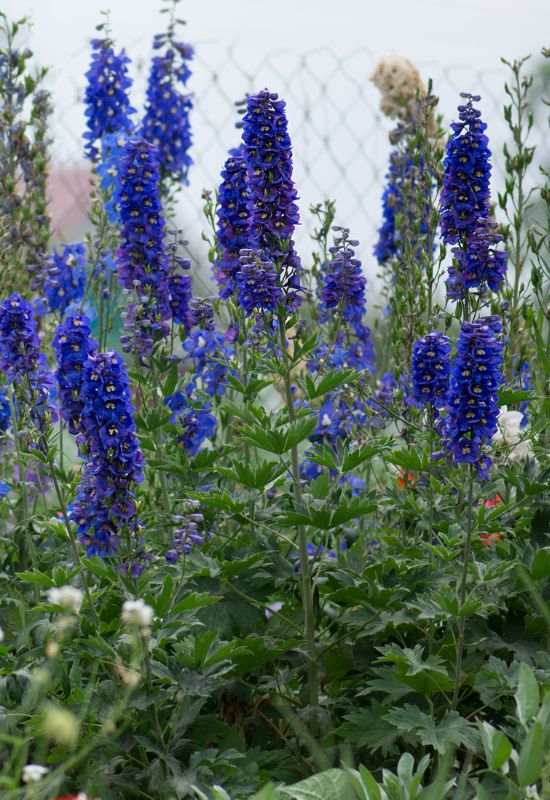
Once again from the New Millennium Series, ‘Cobalt Dream’ is a very showy hybrid cultivar, and one of the most striking of all in the blue range. In fact, growing to 6 feet tall, or 1.8 meters, its strong and upright stem brings its semi double flowers back to the sky, and they have the richest, strongest and most striking cobalt shade ever! True to its name, this perennial variety has very large blossoms as well, about 2 inches across (5.0 cm) with a central bee of small petaloids in ivory white, which offer a lovely contrast.
And it also has a very long blooming season, non stop summer to early fall. They cone very dense on the inflorescence, for a really showy floral display above the broad and deeply cut foliage in mid green underneath, and, of course, attracting lots of butterflies, pollinators and even hummingbirds.
If you like blue, you will love ‘Cobalt Dreams’ delphinium; this larkspur variety ticks all the boxes for a long lasting and vibrant display in an informal border, or in a butterfly garden, and it also gives you really exceptional cut flowers and a striking vertical accent.
12. Canyon Larkspur (Delphinium nudicaule)
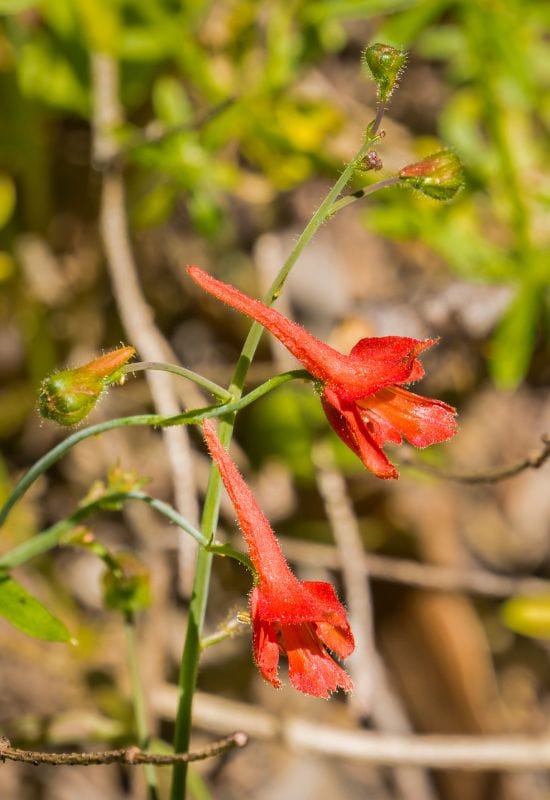
Now I have a little surprise for you… We love delphiniums for their white, pink, blue and purple blossoms, but canyon larkspur is the big exception. In fact, this herbaceous perennial variety native to North America has bright scarlet red flowers! The blooms are not very big, and they open on loose, open racemes, but you can fully enjoy the back spur that holds the nectar that hummingbirds and butterflies love, and the cupped to open petals at the mouth, each little head looking like a trumpet quivering in the breeze…
And it is also different in term of flowering time, as it starts in early spring, and it keeps going all the way to early summer! Shorter than most of her sisters, it only reaches 2 feet tall (60 cm), but the foliage is really striking, with large palmate leaves in bright to mid green, and often with luminous white spots on the, and sometimes even with pinkish margins, while most of the bright to mid green surface has the fine texture of sand!
Unfortunately, canyon larkspur is also the softest variety on our list, so it will nerd a warm and informal garden if you wish to keep it as a perennial. But if you can, this delphinium can really bring its fiery red flowers to beds, borders, containers and even in a rockery.
13. ‘DelfixBlue’ Delphinium (Delphinium grandiflorum ‘Delfix Blue’)
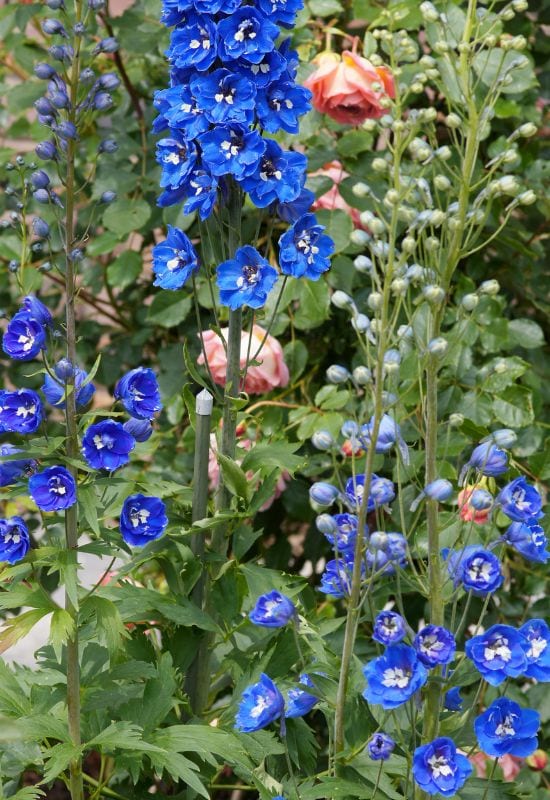
Back to a more traditional color, ‘Delfix Blue’ is a Delphinium grandflorumcultivar, and it is actually a compact and short lived perennial that grows to only 18 inches tall (45 cm). But it in this short space, it will give you lovely blooms that keep a cupped shaped for a long rime, and then open to a star, or anemone type blossom.
When still half opened you will notice the sky to gentian blue petals with a lovely white center. But once they spread out, and they fully unfold, the petals (or tepals to be precise) reveal their crepe paper like texture, and also lavender rose blotches towards or at the tips, sometimes taking on cornflower tonalities.
The 1.5 inches across (4.0 cm) single blossoms will last all throughout summer months, while the fern like rich green foliage will give your garden very fine textured leaves from spring to fall.
Small but very vibrant, ‘Delfix Blue’ is a larkspur variety you can grow in your flower beds, border fronts or also for edging, in informal and butterfly gardens; and it will give its best performance if you group plant it. It could also bring its sky colored blossoms to a small posy.
14. ‘Magic Fountain Lavender White Bee’ Delphinium (Delphinium x elatum ‘Magic Fountain Lavender’)
I would like you to meet a beauty from the Magic Mountain Series, in lavender, of course… But you can pick any of her sisters, in dark or sky blue, white, pink or purple. The full name of our larkspur cultivar is quite long ‘Magic Fountain Lavender White Bee’, but thus perennial is not too tall, only 3 feet tall (90 cm) at the very maximum.
Nevertheless, it forms very columnar inflorescences that are fully packed with the flowers, and they last for a very long time; this early starter is in bloom from late spring to late summer! The semi double flowers are about 2 inches across (5.0 cm), and, of course, bright lavender tending towards mauve.
But the “bee” is nothing to do with the many pollinators and even hummingbirds that will come to visit your garden if you grow it… No, it refers to the small ring of petals (petaloids) in the center, which are snow white and add luminosity and contrast to the floral display. The foliage has the typical shape of the x elatumhybrids, broad, deeply cut and mid green.
Ideal for both beds and borders, but also containers and butterfly gardens, ‘Magic Fountain Lavender White Bee’ delphinium will also offer you excellent cut flowers and a luxurious but also delicate personality.
15. ‘Highlander Bolero’ Delphinium (Delphinium x elatum ‘Highlander Bolero’)
Back to a variegated cultivar, ‘Highlander Bolero’ must be the most flamboyant larkspur of them all! You will notice it in early summer, when the first buds start to open, because its fully double blossoms are just spectacular! To start with, you will find no other delphinium varieties with as many petals, as each blossom on the upright stem can have as many as 58 tepals! And they are also frilled, which gives them and extremely decorative lace or ruff like appearance.
About 2 inches across (5.0 cm), they rise to up to 40 inches tall (100 cm), but what will really amaze you are the colors of the flowers… On them, you will see dashes of really vibrant, super saturated cobalt blue, as e as violet (especially around the edges) which brightens up to lavender, sometimes taking on pink overtones and tending to white in the center! This kaleidoscopic, almost hallucinogenic display will last for about three months above the mound of large, broad and deeply cut mid green leaves that thrives lower down at its feet.
And absolute stunner in any herbaceous border, in containers or for cut flowers, ‘Highlander Bolero’ delphinium must be one of the most vibrant larkspur variety you can ever grow in a sunny informal garden. Its bold and vibrant appearance makes it ideal also for less traditional designs.
16. Dwarf Larkspur (Delphinium tricorne)
We close our journey with a little sister in the genus Delphinium. Native to woody and rocky slopes of Alabama, Arkansas, Georgia, Minnesota, Nebraska, Oklahoma and Pennsylvania, this perennial species only grows to 18 inches tall (45 cm), but it is multi stemmed and an early starter with a lot of charm.
In fact the flowers will open from mid to late spring, on loose but upright racemes with about 6 to 14 heads each. And the blooms are really pretty, about 1.5 inches long (4.5 cm) and with the back spur on full sight, while the front opens to lovely stars with pointed, roughly triangular petals, and they seem to fly in the air like butterflies. Thanks to the very thin. Petioles that hold them…
Then again, real fluttering butterflies, bees and hummingbirds will come to visit this elegant and dainty floral display, mixing the colors of their wings with the amazing cobalt blue of the blossoms, which also have lavender violet dashes and a purple dot at the tips of the tepals. But the foliage is no less attractive, with its palmate leaves, with deep lobes, rich green color and frond like texture.
Here is another species that’s better suited to low flower beds and even rockeries or edging and window boxes rather than herbaceous borders. It won’t “steal the show” as tall and showy varieties of delphinium do, but rather add its decorative touch in a discreet way.
Delphinium Varieties in Many Shades and Shapes for a Garden Full of Colors and Pollinators
All these delphinium varieties are different; some are very tall, others short, some are super showy, others discreet, but in white, blue, pink, lavender, purple, violet and even red, their spurred flowers have all one thing in common: they are magnets for butterflies, bees, pollinators and also hummingbirds!

Written By
Amber Noyes
Amber Noyes was born and raised in a suburban California town, San Mateo. She holds a master’s degree in horticulture from the University of California as well as a BS in Biology from the University of San Francisco. With experience working on an organic farm, water conservation research, farmers’ markets, and plant nursery, she understands what makes plants thrive and how we can better understand the connection between microclimate and plant health. When she’s not on the land, Amber loves informing people of new ideas/things related to gardening, especially organic gardening, houseplants, and growing plants in a small space.

